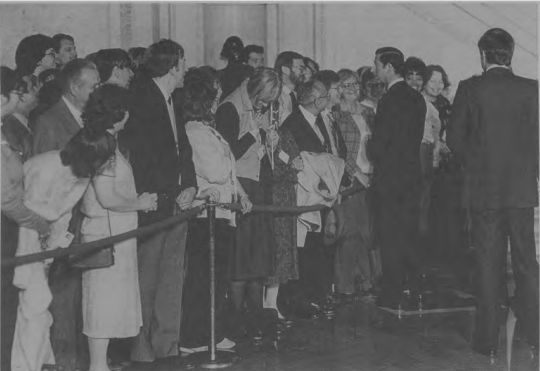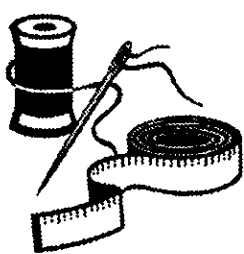Main Body
Chapter 34. Summing it up on My Retirement
BY the time that I retired on January 2, 1993 one of, the reading rooms redesigned–the European Reading Room was completed, giving me the opportunity to see it in its finished state. The new plan had required the installation of book shelving quite high on the left side wall of the reading room. In order to provide access to the books on those high shelves, the architects had constructed staircases at various intervals along that range of shelving. The staircases extended out into the reading room, encroaching on the space provided for reading tables. Also for some reason we could not fathom, the staircases as constructed were narrow and rail-less, wch would make climbing them to reach the uppermost shelves hazardous for the staff and public. I recall the division staff saying that they would hesitate using the staircases, that they planned to put non-used books on those high shelves just for show, so they would not have to climb those stairs to retrieve books.
I had been hoping that in the years since I left the library that this architectural problem had been eliminated or corrected. I have learned that is not the case. The fact is that not only does the European Division have the impractical narrow staircases, they are also to be found in the African and Middle Eastern and in the Asian Divisions’! I understand the Staircases are not being used by either the staff or the public, that the staff in each of the reading rooms has filled the high book shelves with “nice looking” sets with “pretty bindings.”
As I write this part of my narrative, I have also learned that the African and Middle Eastern and the
Asian Divisions and their reading rooms have been moved from the John Adams Building into the Thomas Jefferson Building according to plan, without their book collections which still remain in the John Adams Building. I understand that there are only two book deliveries a day from the Adams Building and that the few deck attendants who service their collections also have other duties. I can’t help but wonder about the effect all this has had on the quality of the Library’s service to readers. I understand that there is the hope that the book collections may be moved to the Jefferson Building in about a year.
The Main Reading Room I am happy to say also was completed by the time that I retired so that I was able to see some of the finished improvements that I had helped to plan for its renovation. The room indeed had been restored as the jewel that it had been when it had originally been opened in 1897, along with improvements such as the installation of cable for computers at every reading desk as well! My joy was dampened somewhat when it was discovered shortly after the room’s opening that dampness was seeping through the roof over the beautifully redecorated dome of the Main Reading Room, threatening to undo the restored artwork.

I was particularly saddened by this because I had campaigned vigorously for several years to get the Architect of the Capitol to do something about replacing the entire copper roof of the entire building. I recall that when Arthur Cotton Moore was hired as the Associate Architect to develop the plans and specifications and construction drawings for the renovation, I was assigned to tour the Thomas Jefferson and the John Adams Buildings with Mr. Moore, some of his staff, and the Architect of the Capitol and some of his staff. At that time, I made a point of showing them the many places in the two buildings that had suffered water leaks over the years, roof leaks as well as plumbing water line leaks in walls and ceilings, etc. and there were many. The problem areas in the domed ceiling of the Main Reading Room were pointed out to them with great emphasis. I showed them place after place where paint had been peeling and plaster was falling because of continued leaks and water seepage that had been occurring over the years. I recall saying to the architects, “I hope that you will see that all these roof, wall and ceiling problems are completely eliminated before any interior renovation and restoration work is done.”
I can see them even now nodding and saying. “Oh! Yes, Mr. D’Alessandro, we will,” as they made notes. That was not the only time that I urged that the Thomas Jefferson roof be repaired or replaced completely and that the other areas I have mentioned be attended to before any interior work was done. There should be many memos in the archives that I have written over the years that will attest to the fact that I strongly felt that such repairs should be accomplished before any restoration and beautification of the interior of the Thomas Jefferson and the John Adams Buildings was attempted. These memos were sent to the Buildings Management Division of the Library and to the Office of the Architect of the Capitol. As things go in the bureaucracy of the government, my urgings did not bear fruit. A great deal of the interior renovation artwork was done before the roof of the Jefferson Building and other leaks in both buildings were fixed, witness the fact that the interior painting of the Main Reading dome showed signs of dampness almost immediately after its reopening. The Architect of the Capitol did not ask for funds from the Congress for the Jefferson Building roof until Fiscal Year 1994, when he finally requested $7,000,000. Lip until that time he had unsuccessfully chosen to try to have sections of the copper roof patched. I understand that the job of replacing the entire roof finally began in 1996, and is nearing completion as I write this in the spring of 1998.
In the summer of 1992, I decided that since I would be celebrating my 80 birthday in March of the following year that it was time that I retire, and gave notice to Mr. Curran. I had had a long and a most satisfying career in two libraries a large urban public library and in the nation’s library. From the time that I started as a page in Cleveland’s Brownell Junior High School Library in 1927, I had spent the better part of 65 years doing library work. It was more than time for me to leave public service even though I knew I would miss all of the wonderful experiences that one has as an employee of the Library of Congress. I had derived such great satisfaction from my work as an officer of the Library for twenty-two and a half years and from the many fun and happy events that came my way as an employee of the Library. During my tour of duty on Capitol Hill, I was privileged to see England’s Queen Elizabeth and Prince Philip, some of our presidents and their wives and other dignitaries when they visited the Library, and on occasion to meet other persons of note. Earlier in this narrative I described the time that Mr. Mumford, Mr. Berry and I were privileged to visit First Lady Patricia Nixon, and then there was the afternoon of November 11, 1985 when I and other staff members were privileged to meet Charles Prince of Wales in the Great Hall of the Library of Congress.
Then there were the many Library programs, literary and musical that I enjoyed during some evenings after work. I shall never forget the many hours of enjoyment provided by the Juilliard String Quartet, the thrill of listening to poetry readings by the various poet laureates who have held that important post over the years along with dramatic readings done by people like Burgess Meredith and so many others like him who have graced the stage of the Library’s Coolidge Auditorium. The foregoing are only a few examples of the many wonderful experiences that came my way as an employee of the Library of Congress, experiences that I shall remember with pleasure for the rest of my days.
Equally important were the many co-workers and associates at the Library of Congress who became my friends and will never be forgotten. As true colleagues they did not let me leave the service without a great going away party, which was held on December 30, 1992. I had hoped that I could leave quietly without any fanfare because I feared that I might get emotional and show my true feelings when it came to leaving the many friends and associates I had come to admire and respect in the Library of Congress. My colleagues would have none of that. At the party, Mr. Curran toasted me in his usual eloquent manner, after which he presented me with several items that have become special mementos. They were, two priceless solid brass bookends made by Virginia Metalcrafters Inc. made to look like the massive historic front doors of the Thomas Building of the Library of Congress the one known as Humanitas and the other known as Intellectus, which I proudly use on my bookshelves in my home in Westlake, Ohio, a beautifully framed document conferring upon me the Library of Congress’ Award for Distinguished Service, which I also proudly display on the wall in my den above my computer. It serves as a warm reminder that I once was privileged to serve in the greatest library in the world! I also received a Library of Congress Library card. Last but not least was a book the blank pages of which had been inscribed
with notes from my many associates. Every now and then I read through it to recall fond memories of those who were an important part of my professional life on Capitol Hill for more than two decades. People like Don Curran, who wrote:
Dear Eddie,
First and foremost-thank you for all the help you’ve given to me over the years. Secondly thank you for 65 years of service to the library community. You have set a standard of excellence that is admired and respected by us all.
And Dr. Thomas Mann, reference librarian and a main-stay in the Main Reading Room, who wrote the following message:
Ed,
You are a librarian’s librarian the -best I’ve ever met. You’ve set an example of service to which I will always aspire.
And Science Reference Librarian Connie Carter, who wrote:
Dear Ed,
Many, many thanks for all your help, good counsel, sound advice, common sense, and support during our many “disasters”–flood, fire, asbestos, dust, dirt.
You know them all.
The foregoing are a small sampling of the many messages written in my retirement memory book,
messages that help me to remember the many fine people who were an important part of my professional career. I owe so much to so many people who have touched me in one way or another during my career as a librarian and public servant. I thank God for bringing all of them into my life and also for blessing me with such a long and rewarding career in a profession that is not properly assessed among professions. And finally, the greatest debt that I owe, is the one I owe both my parents for giving me life, and especially to father for his good counsel and support over the years, which in the last analysis made it possible for me to become what and who I am, a happily retired old-time librarian!

